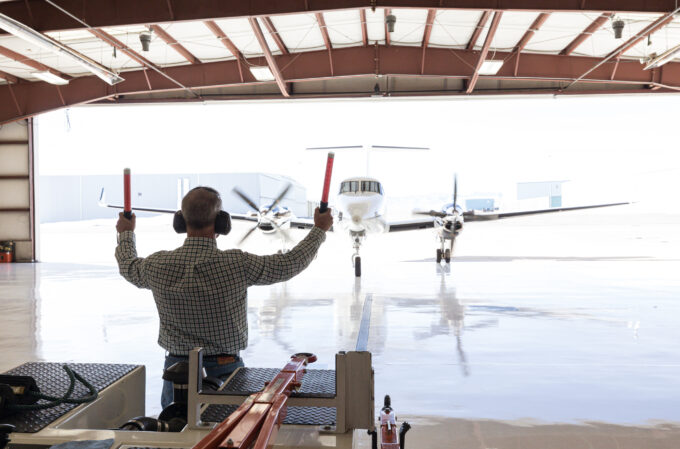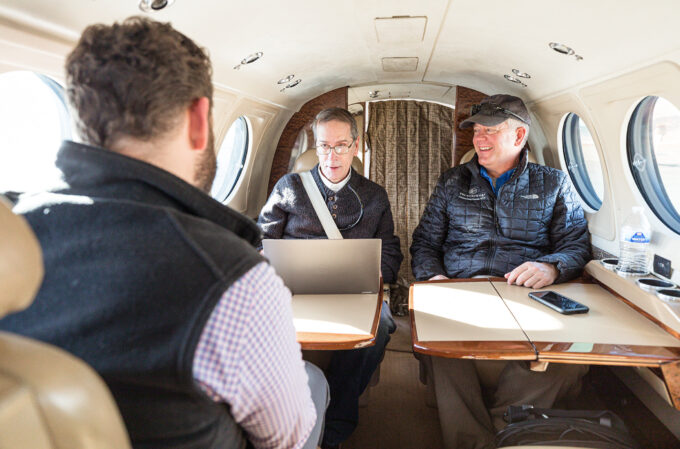It was 1958 when the rural electric co-op that became part of Tri-State G&T built its first power plant in Nucla, on Colorado’s Western Slope. In that same year the company chartered its first aircraft. One of the co-op’s employees and a local flight instructor departed from Montrose, CO in a Cessna 140 for a 23-minute flight over the two-mile-high plateau and 1,000-foot-deep San Miguel Canyon between the two mining towns.
For several years, the Nucla Generating Station was the only coal-fired power plant in Western Colorado. It finally was decommissioned in 2021. Under Tri-State’s Responsible Energy Plan, the co-op plans to produce 50% clean power by 2024. As the co-op builds new solar and wind farms, it is still flying to Nucla – from its modern headquarters in Denver – for reclamation projects at the old site.
“We’re working to decommission our old fossil-fuel-burning facilities, transitioning them to new activity,” said Chris Gilbreath, senior manager of remediation and reclamation. “We’re surrounding our facility in Escalante, NM with solar panels. We’re also exploring retrofitting that plant for blue hydrogen.”
New Deal to New Energy
Tri-State G&T recently received NBAA’s 60-year Flying Safety Award. The story of the flight operation over those decades closely follows the story of rural electrification across the Rocky Mountains (“G&T” stands for “generation and transmission”).
In the middle of the 20th century, when ranchers were first turning on the lights with the help of New Deal programs, the co-op hired that Montrose flight instructor, Ted Nelson, as its first chief pilot. He flew a series of Cessna singles and then a Cessna C310 twin for the company.
“In business aviation, we have to adapt to the company’s needs as they change. ”
BARRY HITT Chief Pilot and Flight Operations Manager, Tri-State G&T
By the early 1970s, engineers and directors were flying several times a week, and the company purchased two Beech King Air E90s and a Piper Super Cub.
As Colorado’s electric power needs grew, so did Tri-State G&T, and the flight operation at its peak operated three King Air 200s, with seven full-time pilots and three maintenance technicians.
Right-Sizing the Operation
Today, Tri-State operates one King Air 200, with three full-time pilots. Chief Pilot and Flight Operations Manager Barry Hitt has guided the operation through periods of rapid growth, declining flight activity and most recently, COVID-19.
“In business aviation, we have to adapt to the company’s needs as they change,” said Hitt. “Lately, our department has downsized some, as our company has closed older plants. As a not-for-profit, we’ve always been about controlling costs, but in the 2010s, Tri-State had a lot of construction going on, and that led to quite an increase in flight activity.”
With one owned King Air 200, the company quickly leased two more beginning in 2008, hired more pilots, and greatly expanded its capability for in-house maintenance at its hangar on Rocky Mountain Metropolitan Airport (BJC).
At the same time, the flight operation began to formalize its safety program. The hangar followed headquarters, undergoing certification by the Occupational Safety and Health Administration (OSHA).
“In 2008, we started pursuing OSHA’s Voluntary Protection Program (VPP), where we proactively invited OSHA on site,” said Hitt. “For a while, we grappled with how to define what’s appropriate in the VPP model and apply it to what we do in flight operations, because VPP is primarily focused on ground-based workplaces.”
The aviation team made many safety improvements during the VPP certification process, especially around the hangar, installing an eye-washing station, adding extra fire extinguishers and requiring the use of hearing protection during run-ups. The team also recorded a King Air safety briefing video that plays in the passenger waiting area before every flight.

The company's King Air 200 flies out of Rocky Mountain Metropolitan Airport (BJC) in Broomfield, CO.
Merging Two Safety Programs
By 2010, the flight department had earned VPP certification and began working toward International Standard for Business Aircraft Operations (IS-BAO) approval. Lead Pilot Josh Thompson took a course in TapRooT® analysis and even became an IS-BAO auditor to acquire an insider’s understanding of what to expect.
“It’s so helpful to have this airplane to get where we need to across the service area, especially in rural places. ”
JENNA HIRSH Senior Safety and Health Coordinator, Tri-State G&T
Procedures, such as always flying with two pilots, were already enshrined in the company’s manuals. With the VPP experience under his belt, Thompson set about creating a procedure for reporting and mitigating hazards, which could also promote continuous improvement (see the sidebar on CHIP reports).
“Whatever protocol you audit under, whether it’s VPP or IS-BAO, they both call for a safety management system (SMS),” explained Thompson. “An SMS is a set of principles that guide your operation. The details matter, but it’s the principles that really count.”
By 2016, Tri-State had earned Stage 1 IS-BAO certification.
“So, we had two separate, but parallel functioning safety management systems,” noted Thompson, “and we needed to merge them, make our safety system more streamlined.”
Merging the two SMS programs took the Tri-State G&T aviation team nearly two years to complete, which involved rewriting manuals to limit duplication. But every step of the process made them safer. In 2019, the flight operation achieved IS-BAO Stage 2 status.
“We went to IS-BAO Stage 2 and stayed there [instead of applying for Stage 3 certification], just because of the amount of change we had gone through,” said Thompson. “A flight department like ours is a reflection of its corporation, and so activity levels drive flight levels.”

A minimum of three passengers is required to dispatch Tri-State G&T's King Air.
Blue Jeans and Work Boots
While flight hours have dipped during COVID-19, Tri-State G&T’s airplane often flies several days a week.
Partnering with a corporate travel vendor for trip requests and scheduling, Hitt has placeholders on the weekly schedule: on Tuesday the airplane usually flies to power plants and transmission facilities around Colorado; on Wednesday it typically goes to sites in New Mexico and Arizona; and so on. When a minimum of three passengers request a trip, the airplane is dispatched.
“An SMS is a set of principles that guide your operation. The details matter, but it’s the principles that really count. ”
BARRY HITT Chief Pilot and Flight Operations Manager, Tri-State G&T
Since Tri-State G&T has a service area much larger than California, the King Air is ideal for trips across the mountains because of its hot-and-high performance and ability to access short runways.
“It’s so helpful to have this airplane to get where we need to across the service area, especially in rural places,” said Jenna Hirsh, Tri-State’s senior safety and health coordinator. “I go to some pretty remote locations. The farthest takes about 13 hours by car. Flying commercial, I’d have to stay several days. With the [company] plane, it’s a quick trip down and back.”
Out of Tri-State’s 1,200 employees, Hitt estimates 300 have flown on the plane, including engineers, environmental experts, safety and training managers, and land surveyors. With the recent plant closures, they all need to spend more time in the field – and be even more efficient than before.
“The majority of passengers are working in the field. We see a lot of blue jeans and work boots,” said Hitt. “We often have a mix of different departments that will share use of the plane. And we’ll make multiple stops during the day, drop off different groups at the stations they need to visit, and then do the same trip in reverse, pick everybody up and fly home.”
Learn more about Tri-State G&T at tristate.coop.

Chief Pilot Barry Hitt leads the flight department.
The Difference Between Safety Reports and CHIP Reports
Tri-State G&T’s safety management system has two different reporting forms: (1) the typical safety form used by many flight operations to identify hazards and (2) what are called “CHIP reports.” CHIP stands for:
- Change Management
- Hot Topics
- Improvements
- Pointers or data trends
“The difference between safety reports and CHIPs is the difference between critical versus non-critical,” explained Lead Pilot Josh Thompson. “That means, safety reports need action taken within about a week, sometimes the same day. With CHIPs, we can take the time to investigate those and do some research.”
The goal of CHIP reports is continuous improvement. Topics often come from industry sources, such as the FAA or fellow operators. The same is true with “pointers” or data on aviation incidents and aircraft performance. Improvements to the hangar and the flying experience can be suggested by the flight crew or even by passengers.
To further illustrate the distinctions, Thompson noted that one safety report alerted pilots to paragliders seen at higher-than-expected altitudes close to Denver International. Meanwhile, a CHIP report was based on the NBAA Safety Committee’s focus area for stabilized approaches. Tri-State took time to carefully consider how to obtain consistent flight data and modify recommended stabilized approach procedures for mountain flying.
Snapshot: Tri State G&T
Aircraft: One King Air B200
Base: Headquartered at Rocky Mountain Metropolitan Airport (RDU)
Personnel: Three captains, two contract pilots and one contract maintenance technician



 International Business Aviation Council Ltd.
International Business Aviation Council Ltd.